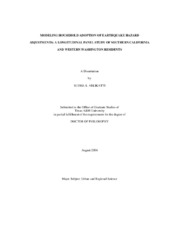| dc.description.abstract | This research, aimed at advancing the theory of environmental hazard adjustment processes
by contrasting households from three cities in a high seismic hazard area with households from
three other cities in a moderate seismic hazard area. It identified seven types of stakeholders
namely, the risk area residents and their families (primary group), the news media, employers,
and friends (secondary group), and federal, state, and local governments (tertiary group), and
explained why they are relevant to the adoption of seismic hazard adjustments. It also addressed
three key attributes— knowledge, trustworthiness, and responsibility for protection—ascribed to
these multiple stakeholders and the relationships of these stakeholder attributes with risk
perception, hazard intrusiveness, hazard experience, gender, resource adequacy, fatalism and
hazard adjustment adoption. It was specifically concerned with the effects of nested interactions
due to trust and power differentials among the seven stakeholders, with the self reported
adoption of 16 earthquake protective measures at two points in time (1997 and 1999).
Some of the key findings indicate that risk perception, gender, fatalism, city activity in
earthquake management and demographic characteristics did not significantly predict hazard
adjustment adoption. However, all stakeholder characteristics had significant positive correlations with risk perception and hazard adjustment, implying a peripheral route for social
influence. Hazard intrusiveness, hazard experience, and stakeholder knowledge, trustworthiness,
and responsibility affected the increased adoption of hazard adjustments by households.
Particularly important are the peer groups’ (employers, friends and family) knowledge,
trustworthiness and responsibility.
These findings suggest, hazard managers cannot count only on the federal, state, and
local government advisories put out through the news media to affect community decisions and
thereby households’ decisions to take protective actions. Instead, hazard managers need to shift
focus and work through peer group networks such as service organizations, industry groups,
trade unions, neighborhood organizations, community emergency response teams, faith-based
organizations, and educational institutions to increase the knowledge, trustworthiness and
responsibility of all in the peer group. This will assure higher household hazard adjustment
adoption levels, thus facilitating a reduction in post disaster losses and recovery time. | en |


